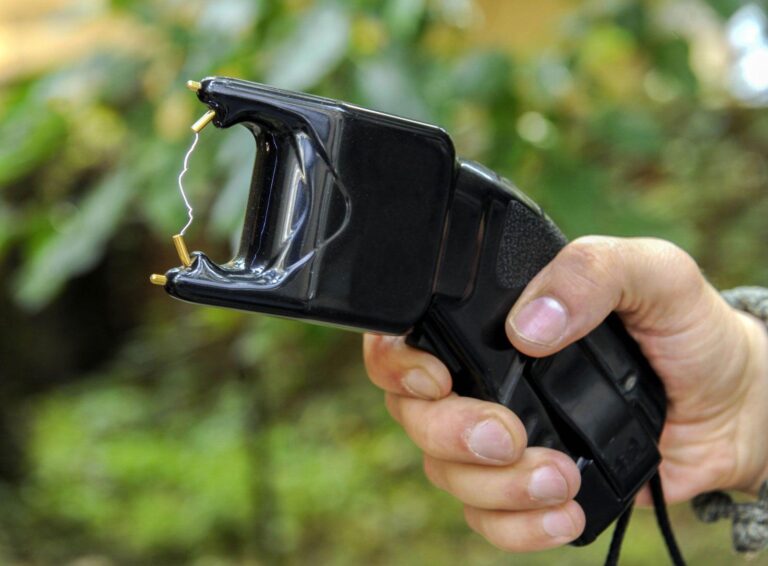Table of Contents
- Understanding the Role of Contact Duration in Stun Gun Performance
- Physiological Impact of Prolonged Exposure on Target Compliance
- Balancing Safety and Effectiveness Through Optimal Contact Times
- Practical Tips for Law Enforcement and Civilian Use to Maximize Stun Gun Efficiency
- Key Takeaways
Understanding the Role of Contact Duration in Stun Gun Performance
When it comes to the performance of a stun gun, the duration of contact between the device and the target plays a pivotal role in determining its effectiveness. A brief touch may deliver a shock, but it often lacks the sustained electrical disruption necessary to incapacitate an attacker thoroughly. The longer the electrodes remain in contact with the skin, the more the electrical current interferes with the nervous system, causing temporary muscle paralysis and disorientation. This interaction isn’t just about the shock itself but about how long the current disrupts nerve signals, which directly correlates with the stun gun’s ability to stop an aggressor effectively.
Key factors influencing the importance of contact duration include:
- Electrical circuit continuity: Maintaining contact ensures a steady flow of current, maximizing the stun’s impact.
- Muscle response time: Longer contact results in prolonged muscle contractions, increasing the likelihood of immobilization.
- Resistance variation: Different skin types and clothing can affect current flow, making contact duration critical to overcome resistance.
Therefore, understanding and harnessing the optimal contact duration can mean the difference between a stun gun that merely startles and one that provides reliable personal protection.
Physiological Impact of Prolonged Exposure on Target Compliance
Extended contact with a stun gun significantly intensifies its physiological effects, leading to increased muscle incapacitation and a higher likelihood of target compliance. The electric current disrupts the nervous system by sending continuous pulses, which overload the target’s muscles and nerves, causing involuntary contractions. As exposure duration increases, the body’s ability to resist diminishes due to muscle fatigue and nerve desensitization, eventually rendering voluntary movement impossible. This extended disruption can also interfere with the central nervous system’s ability to coordinate motor functions, ensuring a more reliable compliance response.
However, the physiological impact isn’t solely limited to muscle control. Prolonged exposure can induce stress responses, including elevated heart rate and adrenaline surges, which together amplify the target’s disorientation and reduce the capacity for coordinated defense. It’s important to recognize the key factors influencing this effect:
- Individual physiology: Fitness level, muscle mass, and nervous system sensitivity vary, altering response times and compliance threshold.
- Electrode placement: Contact points closer to major muscle groups or nerve bundles intensify disruption.
- Exposure time: Progressive increase in the stun duration correlates with stronger incapacitation but also raises safety considerations.
Balancing Safety and Effectiveness Through Optimal Contact Times
Finding the perfect balance between ensuring safety and maximizing the effectiveness of a stun gun hinges largely on how long the device is in contact with the target. Too brief a contact may fail to deliver sufficient electrical impulse to incapacitate an assailant, while an excessively prolonged shock could increase the risk of unnecessary injury or complications. By sticking to optimized contact times, users can achieve immediate compliance without escalating harm, making it a critical factor in responsible self-defense applications.
Key considerations for managing contact duration include:
- Target response: Monitor if the subject is sufficiently deterred before maintaining contact longer.
- Device settings: Use manufacturer guidelines to balance voltage output and contact time.
- Situational awareness: Assess threats continuously; disengage promptly once control is established.
- Legal and ethical implications: Ensure usage adheres to local laws and standards to avoid misuse.
Practical Tips for Law Enforcement and Civilian Use to Maximize Stun Gun Efficiency
Maximizing the effectiveness of a stun gun hinges significantly on how the device is applied during an encounter. Maintaining firm contact with the target for a minimum of 3-5 seconds allows the electrical current to disrupt the body’s neuromuscular system effectively. Short or intermittent touches often result in incomplete incapacitation, giving the target a chance to recover quickly. For law enforcement and civilians alike, understanding this principle ensures that the stun gun delivers its full potential in immobilizing threats without escalating force unnecessarily.
To further enhance stun gun performance, consider these practical approaches:
- Ensure proper grip and aim: Position the electrodes flat against the skin whenever possible, avoiding thick clothing that may reduce conductivity.
- Stay calm and steady: Panic-induced jerky movements can break contact prematurely, diminishing the device’s effect.
- Practice regularly: Familiarity with the stun gun’s operation helps build confidence, ensuring smooth application under stress.
Key Takeaways
In conclusion, understanding how contact duration influences stun gun effectiveness is crucial for both users and manufacturers. While a brief shock may temporarily incapacitate an attacker, maintaining contact for an optimal duration ensures maximum disruption of muscle control without causing permanent harm. Striking the right balance not only enhances personal safety but also aligns with responsible usage guidelines. As stun gun technology continues to evolve, staying informed about these nuances will empower you to use these devices more effectively and confidently in real-world situations. Stay safe and stay prepared!Check Our Other Blogs
- StunGun – Your Trusted Source for Stun Guns, Laws, and Self-Defense Tips
- PepperSprayLaws – Your Trusted Resource for Pepper Spray Information
- StunGunLaws – Your Trusted Guide to Stun Gun Legality and Safety





